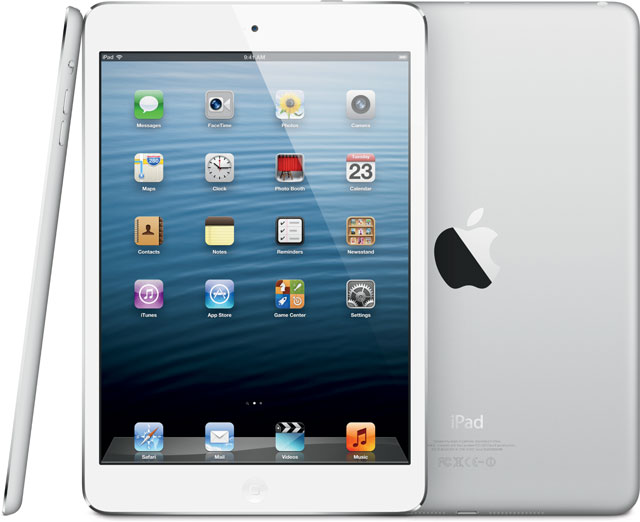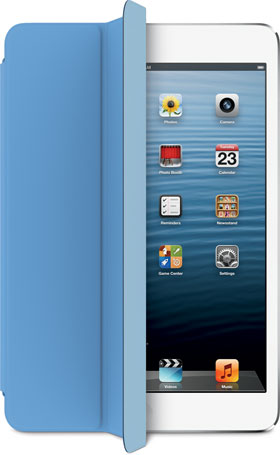
At a glance, Apple’s iPad mini is simply a smaller, cheaper iPad 2. But to think of the iPad mini as some kind of secondary player to the bigger version is a mistake because this isn’t really a step down from its bigger cousin. In many ways, it’s an improvement on the 9,7-inch slate.
The design of the mini is stunning. It takes a lot of its inspiration from the iPhone 5: they both share an anodised aluminium backing as well as a chamfered mirror edge that runs around the border of the device. Overall, build quality and look of the mini is top notch, cuts are seamless, and everything is well crafted. Even though it’s ultra thin and light, it still feels really solid in your hands.
You can’t help but feel you get a more intimate experience when using the iPad mini. The size is still big enough for the normal tablet experience but it’s much more portable, making it great for reading, Web browsing and consuming media.
Because of the smaller size, you get a smaller bezel around the edges. Some reviewers have said it feels a little awkward holding onto the device with their thumbs resting over the screen, but I had no problem doing so and, besides, the iOS operating system has been updated for unwanted touches.
 Overall, though, iOS is identical, so if you’ve used an iPad you’ll know exactly what you’re getting here. And the app selection is by far the iPad’s and, by extension, the iPad mini’s greatest strength.
Overall, though, iOS is identical, so if you’ve used an iPad you’ll know exactly what you’re getting here. And the app selection is by far the iPad’s and, by extension, the iPad mini’s greatest strength.
Underneath the hood in the iPad mini is a dual-core, 1GHz A5 chip paired with a discrete 512MB of RAM. Models come in the usual 16GB, 32GB and 64GB capacities with Wi-Fi and Wi-Fi/cellular options.
Performance on the mini is similar to what we have seen on the iPad 3. Everything is snappy and boot-ups are quick. Battery life is outstanding, easily exceeding the advertised 10 hours. Apps open up nearly instantly, Web browsing is smooth, and graphic-intensive games run at a good frame rate.
Realistically, you can expect a two-year lifespan out of the iPad mini before you’ll feel the need to upgrade, which isn’t bad news at all.
All of the standard iPad buttons and switches are here, with the inclusion of a good-sounding set of stereo speakers (something big iPad’s don’t yet have), along with the new Lightning port. There’s also a 5-megapixel camera around the back that shoots crisp photos with great colour and depth. Video recording at 1080p is similar to the quality of the photos; however, you’ll have a tough time keeping the image stable. It could easily replace a midrange point-and-shoot camera if it was smaller. The front-facing FaceTime 720p camera is handy for video chatting — but beyond that it has limited use.
Much fuss has been made about the 7,9-inch display on the iPad mini. The 1 024×768-pixel resolution makes for a pixel density of 163ppi, which seems underwhelming next to devices like the Nexus 7 (216ppi) or the latest-generation iPad (264ppi). So how does it look? Well, in general terms, not bad at all. Apple is using the same treatment here as it does on the iPhone 5, which makes for a screen that seems to sit just a tiny bit beneath glass. Colours are vibrant, blacks are strong, and games, photos, and videos look great.
That’s only half the story, however. There’s no question that to the naked eye this screen does look lower in resolution than its nearest competition. Pixels are noticeable, especially in Web pages, books, and when viewing e-mail — and that can be distracting sometimes. It’s hard not to notice given the “wow” factor of a Retina display. I don’t think the lower resolution is a deal-breaker, but it is a compromise you need to be aware of.
To wrap up, then, the iPad mini is one of the best tablets on the market. It stands head and shoulders above the competitors in terms of design, the calibre of its components and its build-quality. It’s most certainly worth its R3 399 entry price.
Yes, the screen is a disappointment. But it’s far from terrible. Holding out for a possible Retina display next year might not be a bad idea if you have the luxury of waiting.




